Biological relationship between different organisms
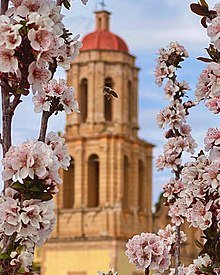
Pollinating Bees
Source: Wikipedia, Author: Tmasjeg, CC BY-SA 4.0
In a community, there exist various kinds of biological association between organisms of different species in an ecosystem. An organism's association with it environment are crucial to the survival of that organism and functioning of the ecosystem.
No organism as a whole can survive without interacting with another different species. Living organism of different species goes into a relationship with another different organism voluntarily or involuntarily.
Biological association can be harmful or beneficial, For instance, the parasite called tapeworm lives in the small intestine of man where it derives the benefits of a habitat, protection and food. The man who is the host suffers because he loses to the tapeworm part of his food he has eaten and digested. This type of biological association is harm because the man is loosing. As I mentioned earlier, Some association are harmful, others are beneficial and some are neutral. This biological association can be life time in some cases.
There are many different types of biological association but I will like to discuss the three common assisocition which are Symbiosis, commensalism and parasitism.
[1] Symbiosis: symbiosis is any type of a close and long-term biological association between two different biological organisms in which both of them benefit from each other. Symbiosis is a beneficial association and each member is called a symbiont. This type of association can be obligated, meaning that both of the symbionts entirely depends on each other for survival.
Examples of symbiotic association are:
[A] Alga and fungus in lichen
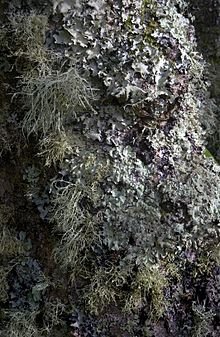
Lichen
Source: Wikipedia, Author:MichaelMaggs, CC BY- SA 3.0
A lichen are a complex life form that is a symbiotic partnership of two separate organisms, a fungus and an alga which live in a close association. In this permanent association, green alga which are photosynthetic in nature produce food and the fungus benefits by using part of the food manufactured by alga. in return, the alga benefits from the fungus enclose and protection from physical damage and also from drier environment than it could otherwise tolerate.
[B] Legumes and Rhizobium
Nitrogen is the most commonly limiting nutrients in plant. Leguminous plants use nitrogen fixing bacteria called Rhizobium in their root nodules to counter the limitation. Rhizobium are group of soil bacteria and they have the abilityto fix nitrogen from the atmosphere. How does rhizobium fix nitrogen fix nitrogen in leguminous plants?
Rhizobiums attaches to the root of leguminous plant and produces nodules. These nodules fix atmospheric nitrogen and convert it into ammonia that can be used by the plant for growth and development. In return, the Rhizobium obtain energy in the form of amino acids from the cells of the host plant, grow and multiply there. This type of association is long term because they can not survive without each other.
[C] Bacteria in the rumen of reminants
Some ruminants animals like cattle, sheep and goat have a special type of stomach called the remen, and they rely on bacteria to help them digest cellulose to sugars, synthesize amino acids and vitamins from other substances which are used by the animals as energy for maintenance while in return, the ruminant provides shelter and nutrient for the bacteria.
[D] Flowers and insects

Pollination
Source: Wikipedia, Author: Debivort, CC BY SA 3.0
Plants and insects have had a long term relationship.
Association between flowering plants and insects is pollination. Pollination is a mechanism by which plants reproduce and it is also symbiotic association in which two interactors reciprocally benefit. Insect pollinators like bees, ants hoverflies, mosquitoes, butterflies and moths can carry pollen grains to spread genetic diversity in a plant generation. In return, insects and other animal pollinators obtain food in the form of energy rich nectar and protein rich pollen from the flowers they visit.
[2] Commensalism
Commensalism is another type of association between individuals of two different species living together in which only one called the commensal benefits from the association while the other is either benefited nor harmed. Commensalism is one of the most common relationship in nature and I've gathered some examples of it to illustrate.
Examples of commensalism includes:
[A] Remora fish and shark
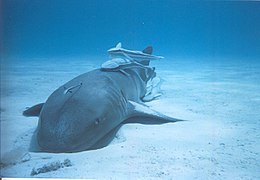
Remora fish and shark
Source: Wikipedia, Author: Duncan Wright, CC BY-SA 3.0
Have you been wondering why Remora attach to sharks? Well Remoras have a special relationship with all sharks. These fish attach themselves to the large marines to get the protection provided by being one with the bigger animal and for food. They also feed off parasites on the shark's skin and in its mouth. Yet their hitching on the shark causes no harm to the shark itself.
[B] Oyster and crab
The habitation of a crab is in the Oyster shell in which case the crab is protected yet no harm is done to the Oyster.
[C] Birds and Trees
Birds that live in the hollows of trees are commensal. Their presence generally does no harm to the tree but the tree provides them with shelter and protection.
[D] Cattle and Egrets
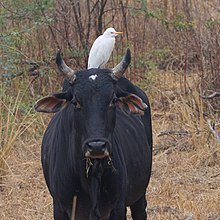
Cattle and Egrets
Source: Wikipedia, Author: Nagarjun, CC BY 2.0
Egrets remove parasitic ticks from the cattle and those ticks that feed on upon cattle's blood can transmit various diseases. Cattle egrets simply scoop up the insects and get a meal and the cattles are unharmed.
[3] Parasitism
Parasitism is a close association between two different organisms in which one known as the parasite live in or on and feed on the expense of the other organism which is known as the host. Parasitism is a persistent long term biological interaction between a parasite and its host. In this association, the host usually suffers harm or may die and the parasite benefits from the relationship.
Parasites that live in the body of their hosts such as man and other animals are called endoparasites. Those that live on or outside the body host where they derive food and shelter from are known as ectoparasites
Examples of Parasitism are:
[A] Mistletoe and plants
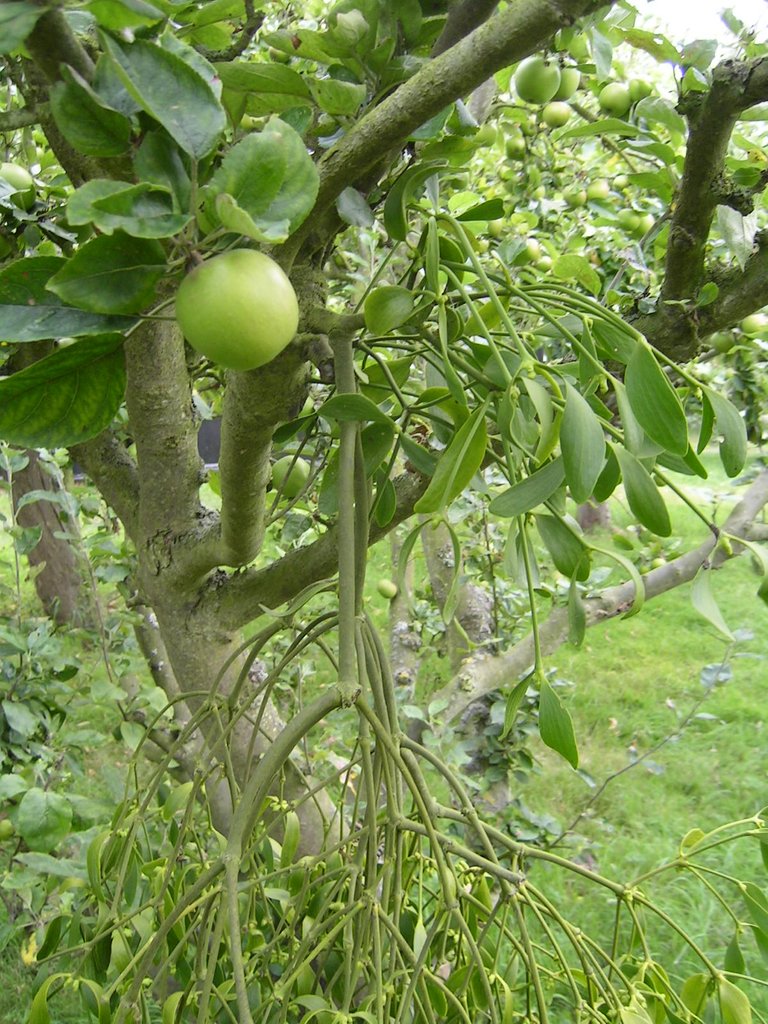
Mistletoe in an apple tree
Source: Wikipedia, Author: Chilepine,
The mistletoe is a plant parasite that grows in the branches of trees such as Hawthorn, poplar and lime. Mistletoe is definitely not your typical shrub, it's a parasite that attack living plants. They benefit from plant's host because the host gives it support and raises it up to a position from which it can receive sunlight. The parasite also absorbs water and mineral salts from the plant while the plant suffers harm by losing to the parasite plant of the water and mineral salts that it has obtained. There are many different species of Mistletoe including some that are dwarf in size. All of them have root systems that are imbedded in the host of the tree and extract nutrients. They are not good for the health of trees.
[B] Man and Tapeworm
Tapeworm is a parasite that live in the small intestine. It has a head called the scolex on which are found rostellum, hook and sucker which enable it to fasten to the lining of the host's intestine. Their flat body surface ensures a large surface area for absorption of already digested food. Also, numerous proglottids in their body aids the adsorption of digested food from its host. Tapeworm derives food, shelter from the human host and cause a parasitic infection called Taeniasis. The human is denied the nutrients that is consumed by the Tapeworm and suffers because he loses to the tapeworm part of the food he has eaten.
Inconclusion, biological association plays a fundamental role in the contemporary biology as well as in recent thinking of philosophy of biology.
`On my next article, we'll be exploring more on predation and competition. Permit me to stop here for now.
Smile.
And thank you for reading my work.
Special thanks goes to @mobbsidian, @dexterdev, @cmplxty and @gentleshaid🙌
Being under their supervision has been amazing experience. Thank y'all for your supports
James appreciates 💕
References
[1] Mistletoe
[2] Shark and Remora association
[3] Commensalism
[4] Pollinators
[5] Flowers pollinators
[6] Symbiosis
[7] Legume
[8] Rhizobium
[9] Symbiosis
[10] Termites and Protozoa
[11] Termites
[12] Lichen
[13] Biological Association
[14] Biological interaction
@tipu curate
Upvoted 👌 (Mana: 24/32)
I appreciates your supports
Congratulations @jsalvage! You have completed the following achievement on the Hive blockchain and have been rewarded with new badge(s) :
You can view your badges on your board And compare to others on the Ranking
If you no longer want to receive notifications, reply to this comment with the word
STOPDo not miss the last post from @hivebuzz:
This is awesome.
Hehe, great work @jsalvage. Can't wait to see you reaching your new target.
BTW, support us back and vote for our witness.
You will get one more badge and more powerful upvotes from us on your posts with your next notifications.
Really cool, I will have to read this in better detail later! There is definitely a symbiotic relationship between so many things that lots of people don't understand. The only relationship I don't care to try to protect is MOSQUITOES! lol hate those things!
Actually, symbiotic association are vital between various organisms of different species, ecology management has broken this association in details. Smile, mosquitoes are not beneficiary rather deadly vector of human beings, I'd bred them as food for fish to feed on.
Thanks for reading my work 🙌
Thanks for your contribution to the STEMsocial community. Feel free to join us on discord to get to know the rest of us!
Please consider supporting our funding proposal, approving our witness (@stem.witness) or delegating to the @stemsocial account (for some ROI).
Thanks for using the STEMsocial app and including @stemsocial as a beneficiary, which give you stronger support.
Hello friend @jsalvage, excellent your article a very relevant topic, you did an excellent description about biological relationships, from my point of view agricultural this type of relationships are beneficial for ecosystems, in the house of mutualistic symbiosis by bacteria of the genus rhizobium they allow to return a considerable amount of nitrogen to the soil, which can be used after going through the process of mineralization, in the case of ruminants, fibrolytic bacteria allow a successful breakdown of fibre (hemicellulose cellulose) to occur in bovine rumen. Good article worth sharing, see you later !
True, biological association helps us in maintaining our ecosystem as well. Some teeny tiny organisms like earth worm symbiotically help farmers, that's also a good relationship! Thank you for reading my work. Please visit my blog again
I'd appreciates🙏
nice article once again :)
I was busy traveling and settling to a new place. Will catch you soon. (Update: This is another plagiarised article. I am taking back my comment. Since I was travelling I was unable to check the plag test on this!!!!)
Alright boss. Please do stay safe over there
Plagiarised article!!!!! (This is just an example)